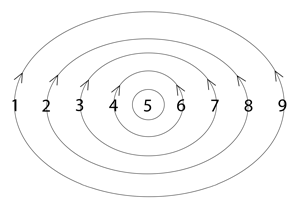life
5-9-5
Conventional Understanding
We typically define “life” as the biological condition separating living organisms from non-living matter. We focus on observable markers—metabolism, reproduction, growth—treating life as something organisms possess that can be measured, extended, or lost. This view has shaped everything from healthcare to legal frameworks, determining when life begins and ends. By reducing life to a biological state, we’ve missed its nature as an active, self-organizing process that both shapes and reflects the patterns flowing through it.
Resonant Understanding
Word Cosmology reveals “life” carrying a 5-9-5 resonance pattern, sharing this numeric signature with “feedback loop,” “self-fulfilling operating system,” and “the information field.” Like a heart that both receives and pumps blood—maintaining rhythm while organizing flow—life functions as a dynamic system that processes information through continuous feedback. This transforms our understanding from seeing life as something we have to recognizing it as what we are—a self-organizing system that continuously integrates and reflects patterns at the midpoint of the creative sequence.
Expressions Spectrum Analysis
In balanced expression, life appears as “being cause” and “integrated attention,” showing how it naturally organizes information without imposing rigid structures. “I know where I am in space” reveals clear positioning within the system, while “organization” demonstrates coherent pattern-making without forcing. These expressions show life as a dynamic system maintaining balance between structure and flow.
When over-modulated, expressions include “defining” and “forceful,” revealing how the system becomes rigid, imposing fixed patterns rather than responding adaptively. “I commit to theorizing” shows conceptualization dominating direct experience, while “personifying attention” demonstrates how awareness becomes projected as separate forms rather than recognized as part of an integrated system.
Under-modulated expressions such as “frequency distortion” and “idle thinking” show what happens when the system lacks sufficient coherence to maintain stable patterns. “I am all alone” reveals the disconnection that occurs when the integrating function weakens, while “being absence of desire” demonstrates how under-modulation corresponds with loss of the motivating pressure that maintains system integrity.
Beyond these patterns, expressions like “lens” and “feedback loop” also share this resonance, highlighting different aspects of life’s organizing function.
Russell’s Cosmogony Connection
Russell’s cosmogony describes nature functioning through rhythmic cycles where opposing forces meet in balanced interchange. He observes how all natural processes follow patterns of contraction and expansion, integration and disintegration. This understanding illuminates life at position 5—the midpoint where these opposing forces achieve equilibrium through dynamic balance.
Like a pump that simultaneously receives and expels, life represents the mechanism that maintains organization through continuous, rhythmic exchange. Throughout Russell’s work, he emphasizes how natural systems operate through balanced pairs of opposing conditions that together create continuous cycles of renewal and transformation.
Imagine a heart beating—each pulse both receives and sends, creating rhythm through balanced action. Similarly, life functions as the self-organizing system that maintains coherence through continuous interchange between integration and reflection—a dynamic balance point that Russell’s work helps us recognize as fundamental to natural systems.
Practical Implications
This understanding transforms how we relate to existence. Rather than seeing ourselves as biological entities possessing life, we might recognize ourselves as dynamic information systems in continuous self-organization.
In practice, this means developing awareness of our own processing system—noticing when we’re imposing excessive structure (over-modulation) or lacking sufficient coherence (under-modulation). The balanced expressions suggest maintaining appropriate organization—neither forcing rigid patterns nor allowing coherence to dissolve.
When facing challenges, we might recognize them as patterns within our system that require either greater integration (if under-modulated) or more flexibility (if over-modulated). By aligning with life’s natural function as a self-organizing information system, we open to more responsive engagement with both our inner experience and the world around us.
Related Words:
No results found.


